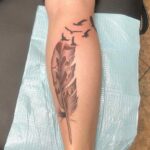Table of Contents
Alright, picture this: a network of notorious Japanese mafia syndicates, their lineage traced back to the 19th century. A vibrant mix of gamblers, con artists, and maybe even some oddballs playing the part of the unexpected heroes, standing against the samurai hired by the powers that be. Welcome to the complex and intriguing world of the Yakuza. Unlike your typical street gang, these groups have left an indelible mark on the world of body art, inspiring a distinct style of tattooing that persists today, drawing in both gang members and art aficionados alike.

Now, where did this name, “Yakuza,” come from? Picture a low-lit room, the air thick with smoke, and a few hard-nosed individuals huddled around a card game. It was a bad hand, a loser, that inspired the name. A poignant metaphor for those dealt a raw deal in life, relegated to society’s bottom rungs.
Fast forward to the present, and it’s a different scene. The Yakuza have swapped their conspicuous garb for the suits of everyday businessmen, and they’ve dipped their toes into the icy waters of the financial world. Their iconic tattoos, a source of both intrigue and stigma, are carefully hidden beneath the fabric of their clothing, a nod to the fact that only a mere one percent of Japanese citizens bear the ink of tattoos.
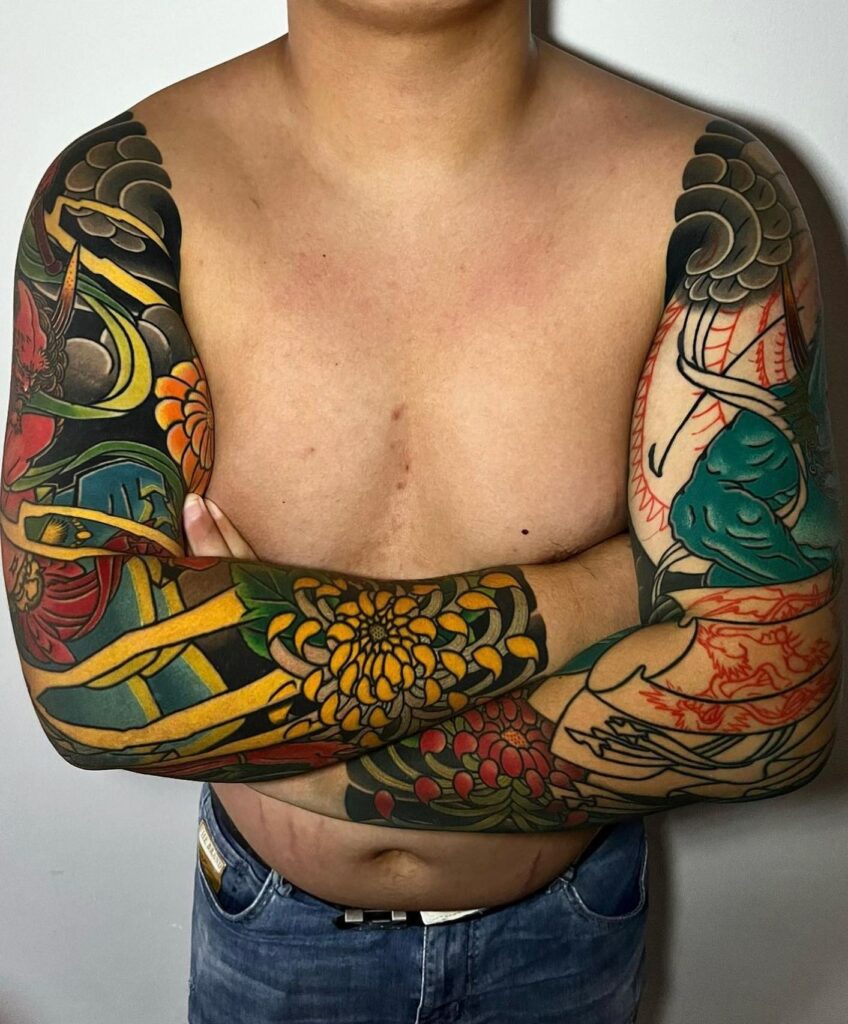
Let me share a story with you. I remember a man named Toshi, who came into our parlor one day. He was a businessman, but beneath his crisp suit was a canvas of colorful tattoos – a sprawling phoenix stretching from his shoulder to his waist. He explained that his father had been a member of the Yakuza and that he’d gotten the tattoo as a tribute to him, but also as a way to connect to a part of Japanese culture that most shunned.
I’ve met countless others who’ve visited our tattoo parlors, each with a unique story. A young woman named Miki, her arm adorned with a vibrant koi fish, a nod to the resilience and strength that the Yakuza tattoos represent, said she got her tattoo as a reminder of her own power and potential. It’s these personal tales, etched in ink, that remind us that behind the stereotypes and stigmas, there’s a rich tapestry of stories waiting to be told.
It’s in these quiet exchanges, where ink meets skin, and a painful history is acknowledged, that the Yakuza tattoos find their place in modern culture. They are a testament to a part of Japanese history that cannot be easily erased or ignored, just like the tattoos themselves.
What is Yakuza?
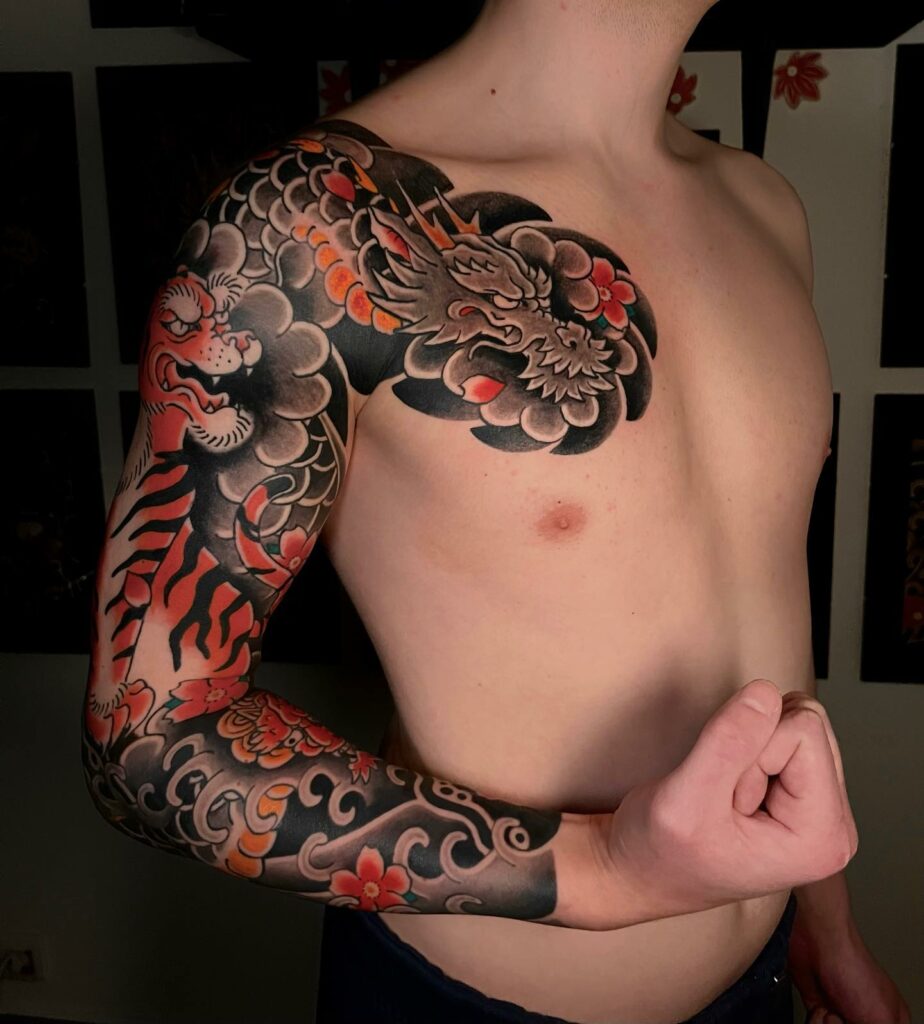
Alright, buckle up, folks! It’s time to take a deep dive into the Yakuza’s canvas of intricate symbolism and personal narratives—the Yakuza Tattoo. Just as we wear our hearts on our sleeves, each Yakuza member wears their identity on their skin. Their ink is more than just art; it’s a story, a testament, a vivid panorama of personal life, values, and aspirations. Consider the samurai Yakuza tattoo—a testament to bravery, a rallying cry against fear. This popular choice illuminates the bearer’s inner warrior, their nobility, and resilience.
Just like old Toshi I met in the parlor who had his father’s Yakuza history sketched onto his skin, these tattoos serve as a unique expression of self. They can be a riot of color or stark black outlines, stretching from the shoulders down to the legs—a canvas that’s as rich in narrative as it is in pigment.
Picture centuries-old woodblock prints. Now, imagine those same intricate designs being etched onto the skin using nara ink, a unique pigment that oxidizes under the skin to a captivating blue-green hue. It was often the woodblock artist themselves who took up the needle and ink, using the same principles that they applied to their print art. These tattoos were also deeply rooted in popular narratives of the time like Suikoden, a tale of heroism and bravery, giving birth to iconic designs featuring dragons, tigers, and flowers.
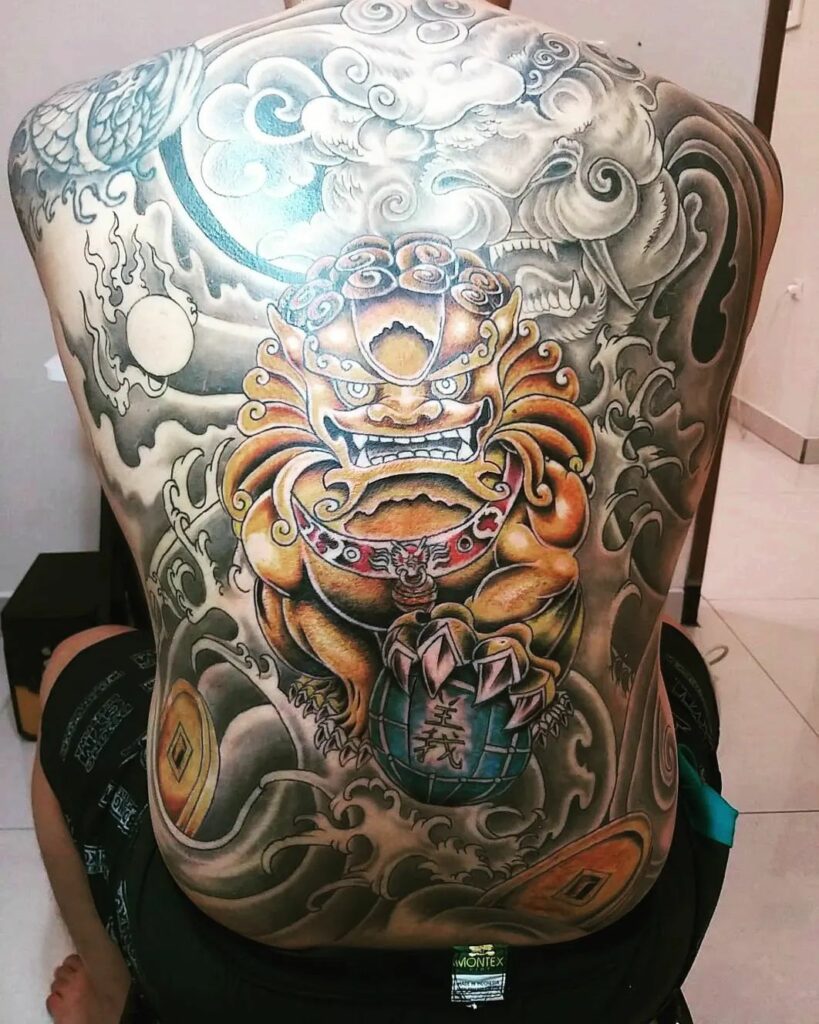
Size mattered too, and the more expansive the tattoo, the more committed the Yakuza member. A good friend, Kazuki, once joked that his backpiece, a stunning, full-bodied dragon, was a testament to his dedication. And the process? It wasn’t just getting inked—it was a ceremony. The Yakuza bore their pain as witnesses looked on, yet they would conceal their elaborate designs in public, revealing them only among their brethren.
Now, let’s travel back in time and touch upon the roots of the Yakuza and their tattoos.
Yakuza Tattoo History
In Japan, during the mid-Edo period (1603-1868), there existed a caste system that relegated the burakumin—the village folks—to society’s lowest rung. Comprising of gamblers, scammers, and those working jobs that no one else wanted, these individuals had to band together for survival. Out of this collective struggle arose the early Yakuza, two groups known as the tekiya and the bakuto, who resorted to theft, scams, and illegal gambling. A peculiar tradition from this time was the punishment of finger joint amputation—imbuing a physical mark of loyalty or disobedience.

These groups began developing their own tattoos, called irezumi, transforming what was once a mark of punishment into an emblem of self-expression. Their tattoos were as defiant as they were, a proud proclamation of their identity in a society that wished to ignore them. Through all the societal crackdowns, the Yakuza remained resilient, thriving in the underground, tattooing themselves, and learning to navigate a world that wasn’t exactly rolling out the red carpet for them.
Let’s shift gears to modern times.
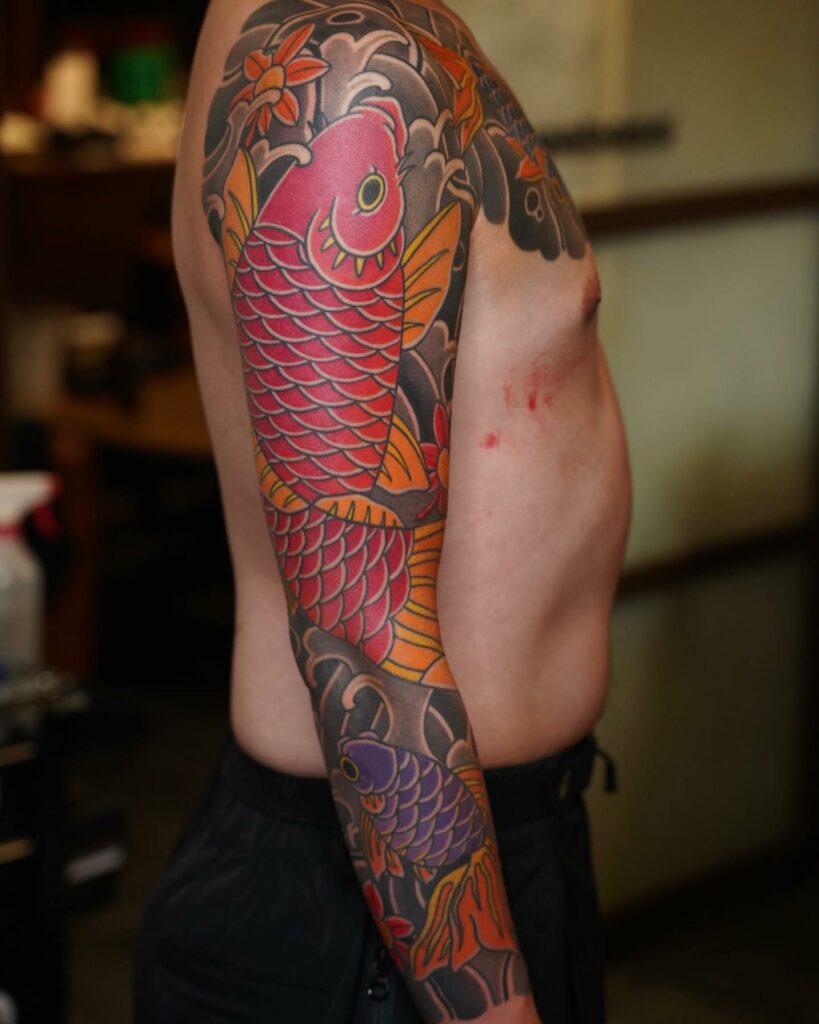
In the present-day Japanese society, the Yakuza are a paradox of sorts—they’re involved in illegal activities like smuggling, blackmailing, and running prostitution rings, yet they’re also engaged in legitimate enterprises, running restaurants and bars. Many view them as the contemporary Robin Hoods or as noble as the samurais, running their operations as a means of survival rather than with a deliberate intent to harm. Even the leader of the Yamaguchi Gumi, one of the most influential Yakuza groups today, described his faction as essentially a charitable entity, offering aid to citizens in need.
Let’s dive into the symbolism etched in the Yakuza tattoos.
Main Themes in Yakuza Tattoos
Dragon tattoos are a staple, symbolizing a ceaseless battle between heaven and earth, a testament to patience and strength. Tigers, on the other hand, are revered as earth’s rulers, offering guidance in the afterlife, strength, and perseverance. A popular theme involves a dragon fighting a tiger, representing the eternal tussle between good and evil.
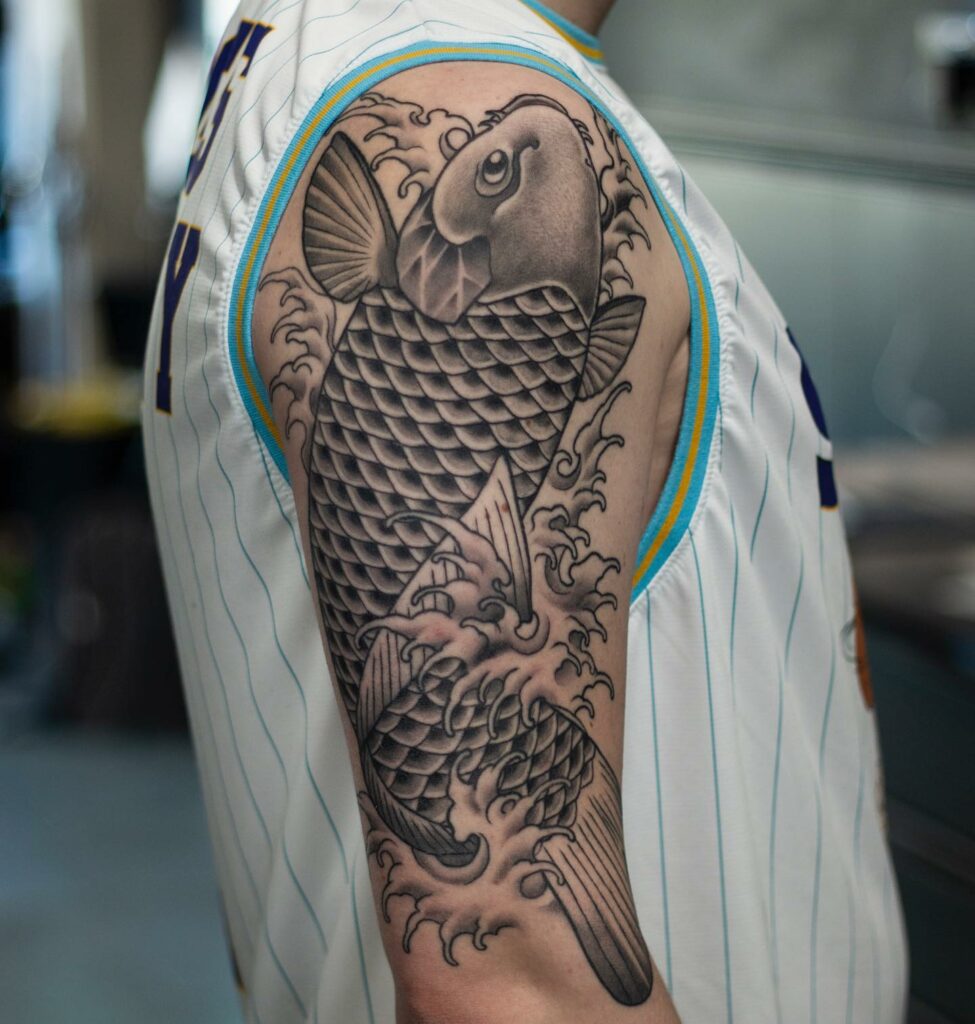
Cherry blossoms, once a symbol for kamikaze pilots, underline the transience of life, a reminder of living right while there’s still time. They are also representative of samurai values—wealth, prosperity, and honor. Koi fish, on the other hand, symbolize good fortune, strength, and resilience, a reflection of a Yakuza’s tenacity in overcoming obstacles. Phoenix tattoos stand for rebirth and triumph over adversity—a clean slate, a fresh start. The snake, although often associated with negative aspects like ill health and misfortune, symbolizes wisdom and power that stems from overcoming struggles.
Now that we’ve gone through this whirlwind journey into the world of Yakuza tattoos, you can see how these designs are not just artwork. They’re narratives of resistance, resilience, and a unique form of self-expression that transcends boundaries and speaks volumes about the wearer’s identity, strength, and commitment. Just like old Toshi and Kazuki, each Yakuza member carries their story, their values, and their defiance on their skin, a proud proclamation to the world and a reminder of their legacy.
More Popular Yakuza Tattoo Designs
As we delve further into the mesmerizing world of Yakuza tattoos, let’s cast our gaze beyond the stoic samurai to other mesmerizing designs that, quite literally, skin-deeply express the soul of Japanese culture.
Take the Koi, for instance. More than just a fish, it’s a symbol of resilience and transformation. According to legend, a brave Koi swam upstream, surmounted a waterfall, and transformed into a majestic dragon. A large, brilliantly colored Koi gracing a sleeve or swirling up a back suggests the wearer’s triumphant journey against all odds. Costs can vary, but given the size and detail of these designs, expect prices to range from $1000 to $5000, depending on the artist and geography.
Then there’s the Hanya mask. Originating from Noh theater, it embodies a tormented female demon, encapsulating wrath, jealousy, and obsession, but also wisdom. Ideally, it’s placed on broad, flat surfaces of the body like the chest or back, allowing the intricate detail and profound emotion of the mask to be fully appreciated. Tattoo expenses for this potent symbol can fall between $500 and $2000.
Remember, these traditional Yakuza tattoos are often applied through the traditional Japanese method of ‘Tebori,’ using hand-held needles. It can be more painful than the modern machine method and has potential risks, like infection, if aftercare is not taken seriously. Moreover, do remember that in Japan, Yakuza-inspired tattoos still carry a stigma and can lead to being barred from places like gyms and hot springs. But, with the right artist and the right aftercare, these powerful designs can become an integral part of your personal story.
Risks Associated With Yakuza Tattoo Designs
Despite the stunning artistry of these tattoos, they still carry a heavy stigma in Japan, primarily because of their association with the Yakuza, the Japanese organized crime syndicates. Historically, tattoos were used as a form of punishment in Japan, marking criminals for their wrongdoings. Over time, this practice morphed into a badge of honor amongst outlaws, and hence, the Yakuza adopted tattoos as a symbol of courage and commitment to the group.
Today, this perception persists. People with visible tattoos are often associated with the Yakuza and can be considered intimidating or disrespectful. Consequently, those with tattoos might be denied entry to public places such as gyms, public baths, hot springs (onsens), and even some hotels. It’s not uncommon to see “No Tattoos Allowed” signs in these venues.
Additionally, because Yakuza tattoos cover large areas of the body—often in a “bodysuit” style—it’s a long, painful process that can take years to complete. They’re typically applied using the traditional Japanese method of Tebori, a hand-carving technique that, while it can yield more vibrant, longer-lasting color and better healing than machine tattoos, is also more painful and time-consuming.
Risks associated with these tattoos are similar to those of any tattoo: infection, allergic reactions to the ink, and scarring. If not performed under sanitary conditions, there’s a risk of serious infectious diseases like hepatitis or HIV. Furthermore, removing these large, intricate tattoos, if you decide they’re no longer for you, is a long, expensive, and often painful process that doesn’t always result in complete removal.
While perceptions have begun to shift slowly with the younger generation and the growing international appreciation for Japanese tattoo artistry, Yakuza-style tattoos still carry a significant societal weight in Japan. Therefore, it’s crucial to consider the cultural implications and potential limitations before embarking on the journey to acquire one.
Conclusion
In the tapestry of human culture and tradition, the Yakuza tattoos occupy a singular space. They’re more than a fashion statement or a youthful rebellion; they’re a colorful chronicle of the bearer’s identity, life, and resilience. As an art form, these intricate designs are a tribute to the human spirit’s audacity, much like the people they adorn. Placement-wise, Yakuza tattoos often cover large portions of the body, typically the back, extending over the shoulders and down to the thighs. While the price varies depending on the artist’s reputation, the complexity, and size of the design, a traditional full-body suit can cost between $10,000 to $30,000, spanning over several years.
However, getting a Yakuza-style tattoo isn’t without its challenges. In Japan, social stigma associated with tattoos persists, with public baths and certain jobs barring individuals with visible tattoos. Furthermore, the traditional method of tattooing—Tebori—while deeply personal and unique, is also more painful and takes longer to heal compared to modern methods. Health risks include potential infections and allergic reactions to the ink. Always ensure to go to a reputable artist who maintains high standards of hygiene and safety.
When it comes to Yakuza tattoos, there’s a rich cultural narrative etched into every stroke, but the commitment is not just to the art—it’s also to the story behind it, the enduring defiance it represents, and the indomitable spirit it salutes. The world of Yakuza tattoos is not just a world of ink—it’s a testament to life lived on one’s own terms, with all the costs, the pain, and ultimately, the strength it confers.


